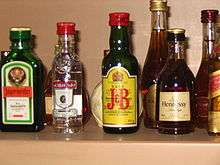Guaro (drink)
Guaro is a liquor made in many places in Latin America. A clear liquid distilled from sugar cane juices, it has a slightly sweeter taste than comparable liquors (40% Alcohol). It is popular in Colombia, Panama, Costa Rica, Ecuador, El Salvador, Guatemala, Honduras, and Nicaragua, although in many places the word "guaro" can refer to almost any liquor.
The name "guaro" came from Central America. Colombians call it aguardiente. Sometimes it is referred to as a "soft vodka" because it has a lower alcohol content than vodka.
Clandestine production
In Costa Rica, the government nationalized its manufacture in an effort to quell the clandestine production of liquor. The Fabrica Nacional de Licores (National Liquor Factory) was founded for this reason, and currently produces the only legal brand, Cacique Guaro. Clandestine liquor production is still prevalent, but it is seen more as a tradition than a business as it would be difficult to compete with the nationally produced guaro. The illegal version of the product is often called guaro de contrabando ("smuggled guaro") and is produced by various methods, all through distillation, but with different base ingredients, typically fruits or sweets from other sources, molasses from sugarcane, or simply sugar.
Export
In 2004, the Costa Rican company S. Guaro LLC began exporting guaro to California in the United States.[1] In 2005, Tranquilo Imports began marketing Guaro Tranquilo in Texas in the United States.[2] As of 2007, guaro was still difficult to find in U.S. markets.[3]
References
Notes
- ↑ Humble guaro goes to West Coast to be a star A.M. Costa Rica, April 21, 2004.
- ↑ Barnes, Michael (May 5, 2005). Gotta guaro? Coming soon to a bar near you. Riverside Press-Enterprise, Cox News Service. Archived August 26, 2005, at the Wayback Machine.
- ↑ Dowd, William M. (July 3, 2007). Down on Drinks: Costa Rican Treat Elusive. Falls Church News-Press. Archived July 16, 2011, at the Wayback Machine.
Sources
- "Ley Reguladora de la Venta de Bebidas Alcoholicas. Expediente Nº 15.477 (22 de noviembre de 2005)". Archived from the original on 2008-03-09. English translation Costa Rican law regulating sale of alcohol.



